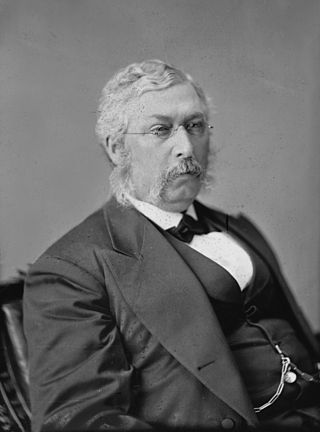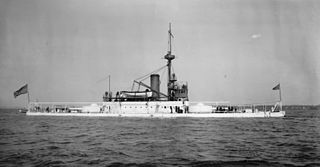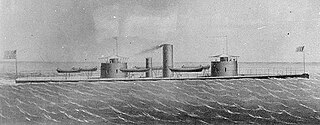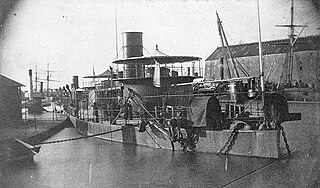
An ironclad was a steam-propelled warship protected by steel or iron armor constructed from 1859 to the early 1890s. The ironclad was developed as a result of the vulnerability of wooden warships to explosive or incendiary shells. The first ironclad battleship, Gloire, was launched by the French Navy in November 1859, narrowly preempting the British Royal Navy. However, Britain built the first completely iron-hulled warships.
USS Agamenticus was one of four Miantonomoh-class monitors built for the United States Navy during the American Civil War. Commissioned as the war was ending in May 1865, the ironclad saw no combat and was decommissioned in September and placed in reserve. The ship was reactivated in 1870, having been renamed Terror the previous year, and was assigned to the North Atlantic Fleet where she served in the Caribbean Sea. The monitor was decommissioned again in 1872 and was sold for scrap two years later. The Navy Department evaded the Congressional refusal to order new ships by claiming that the Civil War-era ship was being repaired while building a new monitor of the same name.

George Maxwell Robeson was an American politician and lawyer from New Jersey. A brigadier general in the New Jersey Militia during the American Civil War, he served as Secretary of the Navy, appointed by President Ulysses S. Grant, from 1869 to 1877. A member of the Republican Party, he also served two terms as a U.S. Representative for New Jersey from 1879 to 1883.
The first USS Miantonomoh was the lead ship of her class of four ironclad monitors built for the United States Navy during the American Civil War. Completed after the war ended in May 1865, the ship made one cruise off the East Coast before she began a voyage across the North Atlantic in May 1866 to conduct a lengthy showing the flag mission in Europe. Miantonomoh was decommissioned upon her return in 1867, but was reactivated two years later and assigned to the North Atlantic Squadron before decommissioning again in 1870. The monitor was sold for scrap three years later as part of a scheme where the Navy Department evaded the Congressional refusal to order new ships by claiming that the Civil War-era ship was being repaired while building a new monitor of the same name.

USS Terror —the totally rebuilt version of the earlier monitor Agamenticus, which had shared the Terror's name—was an iron-hulled, twin-screw, double-turreted monitor of the Amphitrite class; on June 23, 1874 by order of President Ulysses S. Grant's Secretary of Navy George M. Robeson in response to the Virginius Incident laid down at Philadelphia contracted by William Cramp & Sons. Her construction progressed over the next three years until suspended in 1877. Work was resumed six years later, and the monitor was launched on 24 March 1883.

The second USS Miantonomoh, an iron‑hulled, twin‑screw, double‑turreted monitor of the Amphitrite class; on June 23, 1874 by order of President Ulysses S. Grant's Secretary of Navy George M. Robeson in response to the Virginius Incident was laid down contracted by Delaware River Iron Ship Building and Engine Works of Chester, Pennsylvania; launched 5 December 1876; and commissioned in an uncompleted condition on 6 October 1882, Commander Francis J. Higginson in command.

USS Puritan was one of two ocean-going ironclad monitors designed by John Ericsson during the American Civil War of 1861–1865. Launched in mid-1864, construction was suspended sometime in 1865. The Navy Department had specified two twin-gun turrets over Ericsson's protests, but finally agreed to delete the second turret in late 1865. The Navy Department evaded the Congressional refusal to order new ships in 1874 by claiming that the Civil War-era ship was being repaired while building a new monitor of the same name.

The second USS Puritan was a Puritan-class monitor in the United States Navy, constructed in 1882. She was the only ship in her class.

USS Monadnock was one of four Miantonomoh-class monitors built for the United States Navy during the American Civil War. Commissioned in late 1864, she participated in the First in December and Second Battles of Fort Fisher in January 1865. The ship was later assigned to the James River Flotilla on the approaches to the Confederate capitol of Richmond, Virginia and then sailed to Spanish Cuba to intercept the Confederate ironclad CSS Stonewall.

USS Tonawanda was one of four Miantonomoh-class monitors built for the United States Navy during the American Civil War of 1861–1865. Commissioned in 1865 after the war ended in May, the ship was decommissioned at the end of the year, but was reactivated to serve as a training ship at the United States Naval Academy in 1866. She was renamed Amphitrite in 1869 and was decommissioned again in 1872. The monitor was sold for scrap the following year. The Navy Department evaded the Congressional refusal to order new ships by claiming that the Civil War-era ship was being repaired while building a new monitor of the same name.

The Casco-class monitor was a unique class of light draft monitor built on behalf of the United States Navy for the Mississippi theatre during the American Civil War. The largest and most ambitious ironclad program of the war, the project was dogged by delays caused by bureaucratic meddling. Twenty ships of the class were eventually built at great expense, but proved so unseaworthy when trialed that they were quickly sidelined, causing a public scandal.

The Miantonomoh class consisted of four monitors built for the Union Navy during the U.S. Civil War, but only one ship was completed early enough to participate in the war. They were broken up in 1874–1875.

John Roach was an American industrialist who rose from humble origins as an Irish immigrant laborer to found the largest and most productive shipbuilding empire in the Reconstruction Era United States, John Roach & Sons.
Reaney, Son & Archbold was a 19th-century American iron shipbuilding company located on the Delaware River at Chester, Pennsylvania. The company was established in 1859 by Thomas Reaney but it was undercapitalized from the outset, and like many other American shipbuilding companies, fell victim to the shipbuilding slump that followed the American Civil War.
The Delaware River Iron Ship Building and Engine Works was a major late-19th-century American shipyard located on the Delaware River in Chester, Pennsylvania. It was founded by the industrialist John Roach and is often referred to by its parent company name of John Roach & Sons, or just known as the Roach shipyard. For the first fifteen years of its existence, the shipyard was by far the largest and most productive in the United States, building more tonnage of ships than its next two major competitors combined, in addition to being the U.S. Navy's largest contractor. The yard specialized in the production of large passenger freighters, but built every kind of vessel from warships to cargo ships, oil tankers, ferries, barges, tugs and yachts.

The second USS Monadnock was an iron-hulled, twin-screw, double-turreted monitor of the Amphitrite class in the United States Navy which saw service in the Spanish–American War.

The Kalamazoo-class monitors were a class of ocean-going ironclad monitors begun during the American Civil War. Unfinished by the end of the war, their construction was suspended in November 1865 and the unseasoned wood of their hulls rotted while they were still on the building stocks. If the four ships had been finished they would have been the most seaworthy monitors in the US Navy. One was scrapped in 1874 while the other three were disposed of a decade later.

The Continental Iron Works was an American shipbuilding and engineering company founded in Greenpoint, Brooklyn, in 1861 by Thomas F. Rowland. It is best known for building a number of monitor warships for the United States Navy during the American Civil War, most notably the first of the type, USS Monitor. Monitor's successful neutralization of the Confederate ironclad CSS Virginia in the 1862 Battle of Hampton Roads—the world's first battle between ironclad warships—would come to heavily influence American naval strategy both during and after the war.

















